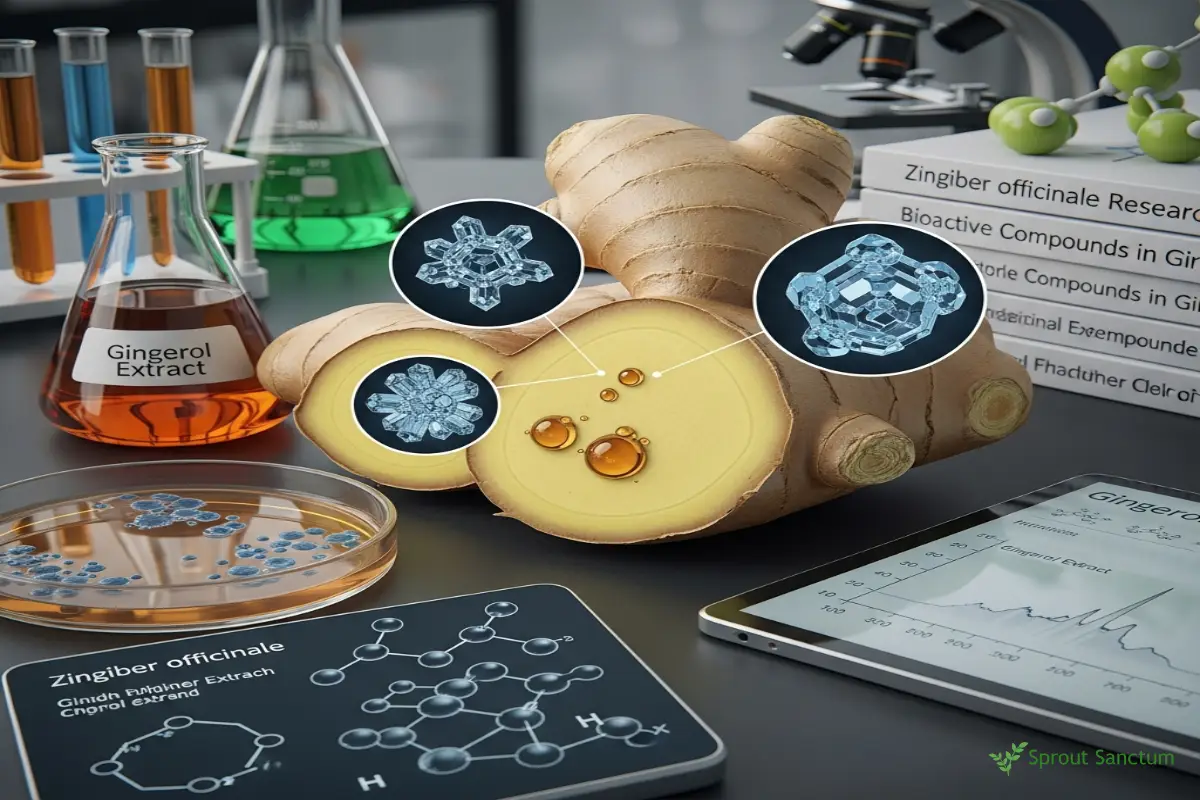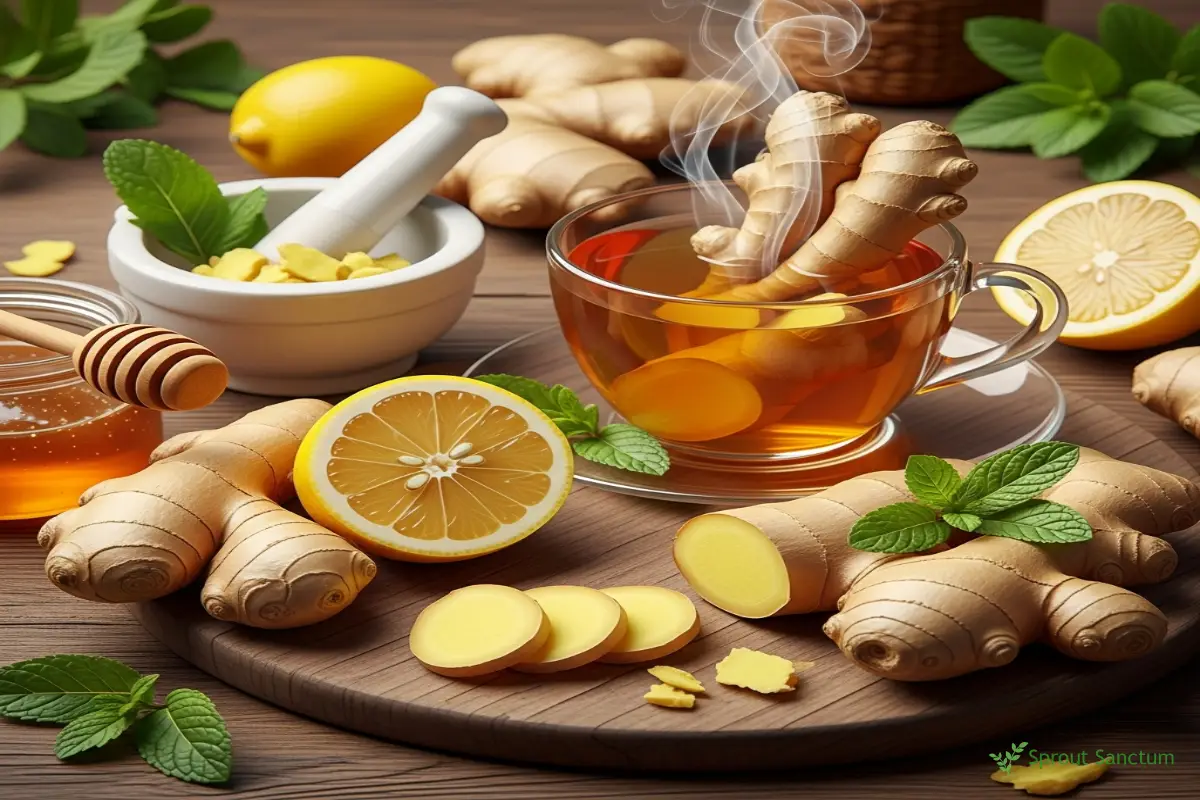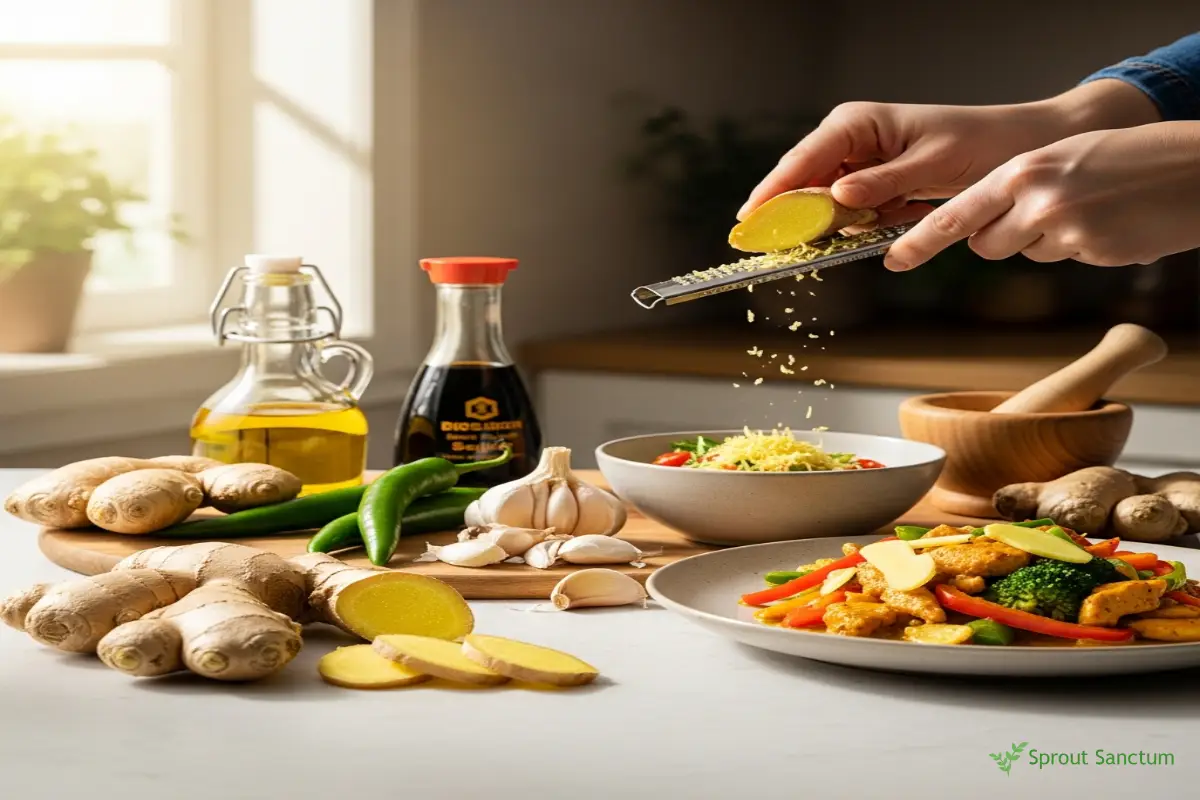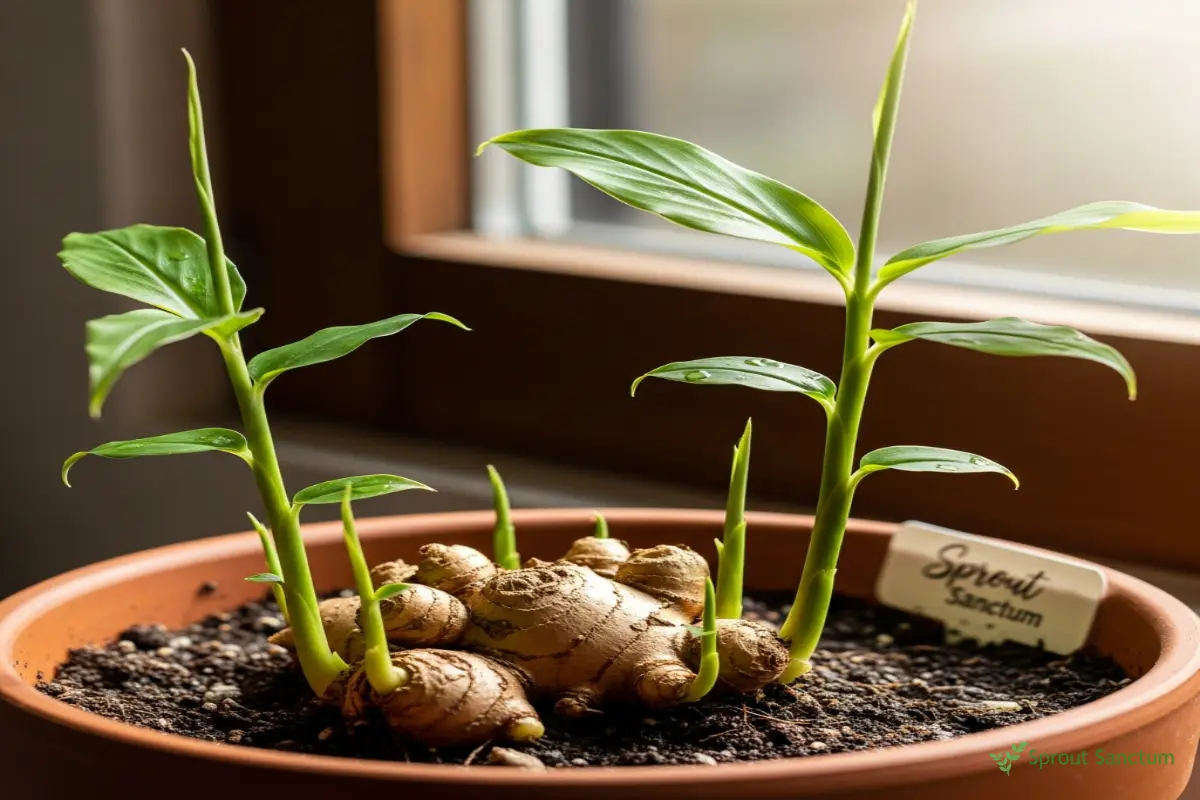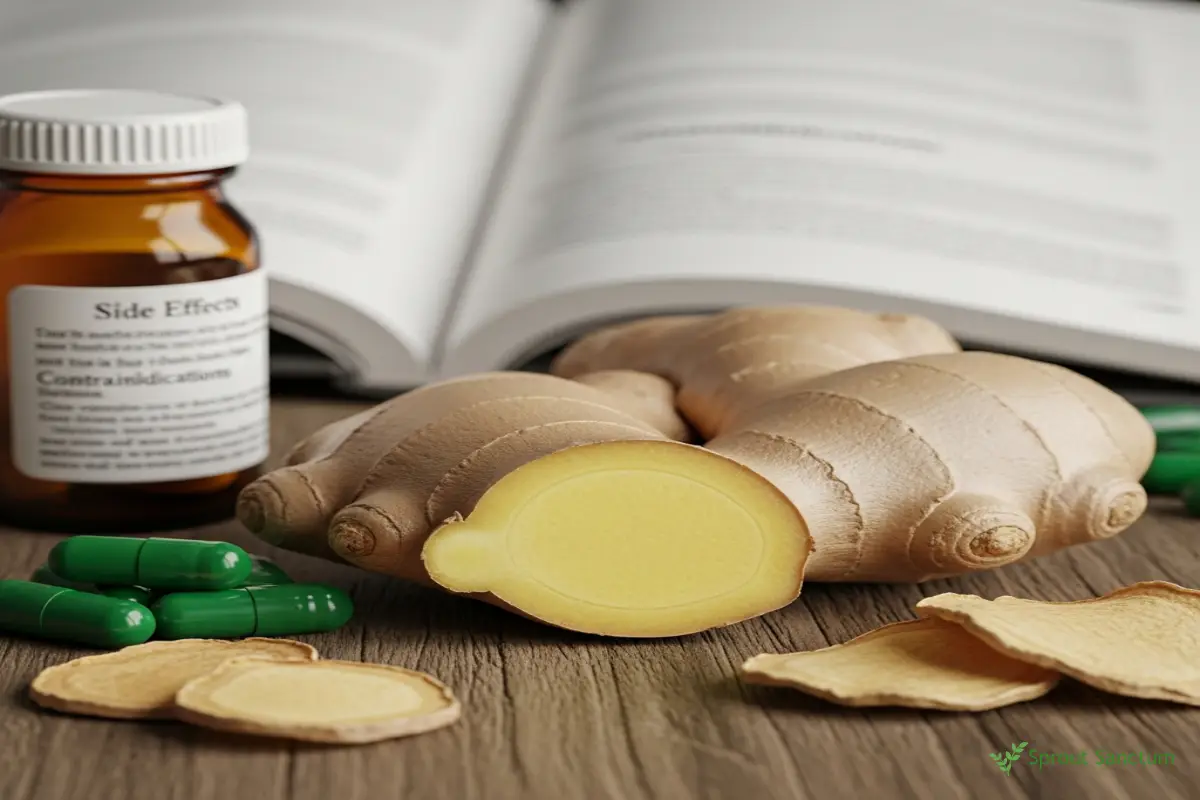Ginger: The Root of Wellness – Cultivation, Cuisine, and Health Benefits
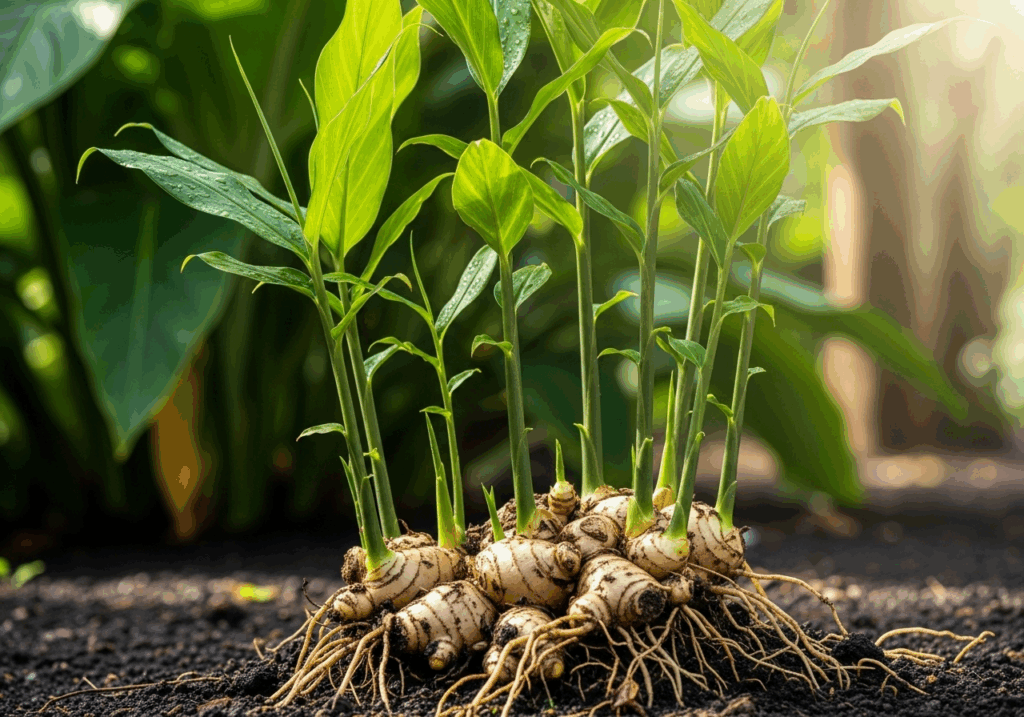
Sep
Introduction: The Wonderful World of Ginger
What is Ginger? Botanical Description & History
The ginger plant is more than just a culinary ingredient; it is a botanical marvel with a rich history rooted deeply in human civilization. Understanding its fundamental characteristics provides insight into its widespread use and enduring legacy.
Botanical Name
The official botanical name for ginger is Zingiber officinale. This nomenclature places it within the Zingiberaceae family, which also includes other well-known aromatic plants like turmeric and cardamom. The term “Zingiber” is derived from the Sanskrit word “singavera,” meaning “horn-shaped,” a fitting description for its distinctive rhizome.
Appearance
The ginger plant is a perennial herbaceous plant, resembling a lily or bamboo in its growth pattern. The ginger plant stems from a creeping horizontal rhizome, the prized segment of the plant, just beneath the soil’s surface. Above ground level, it carries slender, spear-like, bright green leaves that have a height of anywhere from three to four feet (around 90-120 cm). The ginger plant, in temperate climes, in summer, might produce significant yellowish-green or green-purple flowers that emerge on separate, short stems and tend to resemble small pinecones before opening. Although lovely, they’re not nearly as frequently plucked as the pungent rhizomes.
Origin and Historical Significance
The science behind ginger spice: Nutritional Profile and Active Compounds
The potent benefits and characteristic taste of the ginger plant stem from its complex nutritional profile and a rich array of bioactive compounds. These components work synergistically to deliver its therapeutic and aromatic qualities.
Key Bioactive Compounds
The most significant active compounds in ginger are gingerols. These substances constitute approximately 25% of ginger’s pungent components and are primarily responsible for its distinct fragrance, spicy flavor, and many of its primary therapeutic effects. Research indicates that gingerols share structural similarities with acetylsalicylic acid, a compound known for its pain-relieving properties, explaining some of ginger’s anti-inflammatory capabilities.
Another group of pungent compounds found in ginger are shogaols. These are formed when ginger is dried or cooked, through a chemical change of gingerols. Shogaols contribute significantly to the intensely spicy taste of dried ginger and are also known for their potent anti-inflammatory and antioxidant activities, often surpassing those of gingerols in dried forms.
Essential Oils
Beyond pungency, ginger’s characteristic aroma is attributed to its essential oils, which typically make up 2.5-3% of its composition. These volatile compounds include curcumene, alpha-farnesene, beta-eudesmol, beta-sesquiphellandrol, and zingiberol. The fresh, slightly lemony scent often associated with ginger is due to the presence of neral and geranial. These essential oils not only contribute to ginger’s sensory appeal but also possess their own set of therapeutic properties, including antimicrobial and antioxidant effects.
Vitamins, Minerals, and Antioxidants
While not a primary source of macronutrients, the ginger plant’s rhizome is rich in vital micronutrients. It has a high water content (approximately 81%) and a moderate amount of carbohydrates (around 11%). More notably, it contains significant amounts of essential minerals such as potassium, phosphorus, magnesium, iron, manganese, copper, iodine, sodium, and zinc. These minerals are crucial for various bodily functions, from nerve transmission and muscle contraction to bone health and immune response.
Ginger also provides small but notable amounts of vitamins B, C, and E, which are essential for overall health, energy metabolism, and immune function. Perhaps one of the most celebrated aspects of ginger’s nutritional profile is its rich antioxidant content. These powerful compounds help protect the body’s cells from oxidative damage caused by free radicals, which is a key factor in aging and the development of chronic diseases.
Despite its powerful impact, fresh ginger is remarkably low in calories, with a typical serving of 6 grams containing only about 5 calories, making it a guilt-free addition to any diet. This blend of potent bioactive compounds, essential oils, and vital nutrients positions the ginger plant as a truly extraordinary functional food, offering a wide spectrum of benefits for health and well-being.
| Category | Examples | Key Benefits |
|---|---|---|
| Bioactive Compounds | Gingerols, Shogaols, Zingerone | Anti-inflammatory, antioxidant, digestive aid |
| Essential Oils | Curcumene, β-Bisabolene, Cineole, Citral | Flavor, aroma, antimicrobial properties |
| Vitamins & Minerals | Vitamin C, Vitamin B6, Potassium, Magnesium, Manganese | Immune support, energy metabolism, heart health |
Extensive Health Benefits of Ginger: A Natural Remedy
The ginger plant has been revered for millennia in traditional medicine systems for its broad spectrum of health benefits. Modern scientific research continues to validate many of these ancient claims, highlighting ginger’s potential as a natural therapeutic agent.
Nausea and Vomiting Relief
Perhaps one of the most well-known applications of ginger is its exceptional ability to alleviate nausea. It has been extensively studied and shown to be highly effective for various types of nausea, including:
- Motion Sickness: Ginger helps calm the stomach and reduce the symptoms associated with travel sickness.
- Chemotherapy-Induced Nausea: Patients undergoing chemotherapy often find ginger helpful in reducing the severity of their nausea.
- Pregnancy-Related Morning Sickness: Numerous studies support ginger’s safe and effective short-term use for relieving nausea and vomiting during pregnancy. The gingerols are believed to act as serotonin antagonists, modulating the release of serotonin in the gut, which plays a key role in nausea signals.
Promoting Digestive Health
Ginger is a powerful ally for the digestive system. It encourages gastrointestinal motility, meaning it helps food move more efficiently through the digestive tract. This action improves overall digestion by stimulating the secretion of saliva, gastric juice, and bile, all of which are crucial for breaking down food. Regular consumption can help alleviate common digestive discomforts such as bloating, gas, and constipation, promoting a healthier gut environment.
Potent Anti-inflammatory and Pain Reduction
The ginger plant is celebrated for its powerful anti-inflammatory properties, largely attributed to the gingerols and shogaols. These compounds inhibit the production of inflammatory mediators in the body. This makes ginger particularly helpful for conditions characterized by inflammation and pain, including:
- Arthritis and Rheumatism: Many individuals with these conditions report reduced joint pain and stiffness with regular ginger intake.
- Joint and Muscle Pain: It can alleviate general aches and pains, including those from intense physical activity.
- Sports Injuries: Ginger can aid in the recovery process by reducing inflammation and soreness in injured tissues.
Boosting the Immune System
Ginger acts as a natural immune booster, helping the body defend itself against infections. Its compounds possess antibiotic effects and are effective in combating various pathogens. It’s a popular remedy for common ailments like colds, flu, and coughs, acting as a natural expectorant to help clear congestion and soothe respiratory passages.
Powerful Antioxidant Properties
As mentioned in its nutritional profile, ginger is rich in antioxidants. These compounds play a critical role in protecting cells from damage caused by free radicals, unstable molecules that contribute to oxidative stress. By neutralizing free radicals, ginger’s antioxidants can potentially slow down cellular aging, support cellular repair, and contribute to overall vitality, including benefiting cardiovascular health by protecting blood vessels from oxidative damage.
Exploring Potential Anti-cancer Effects
Emerging research suggests that the ginger plant may possess potential anti-cancer properties. Studies indicate that compounds in ginger can induce cell death in certain cancer cells, such as those associated with ovarian cancer. Furthermore, it has shown promise in protecting against colorectal cancer and inhibiting the growth of various cancer cells, including those found in the colon and prostate. While these findings are promising, more extensive human trials are needed to fully understand ginger’s role in cancer prevention and treatment.
Aiding in Weight Management
Ginger’s thermogenic properties can contribute to weight management efforts. It has been observed to increase the body’s metabolism, which can aid in fat burning. Additionally, ginger can help reduce appetite by promoting a feeling of fullness, leading to decreased calorie intake. Research also suggests its potential to help reduce blood sugar and cholesterol levels, which are often associated with weight-related health concerns.
Improving Blood Circulation
The ginger plant contains magnesium and zinc, two minerals that are vital for healthy blood circulation. These minerals help relax blood vessels and improve blood flow. Regular consumption can also help prevent the buildup of “bad” cholesterol (LDL) in the liver, potentially reducing the risk of cardiovascular events such as stroke.
Benefits for Hair and Skin
Beyond internal health, ginger offers external benefits. Its antifungal properties can be helpful in treating dandruff and other scalp conditions. When used topically, for example, as a gentle facial scrub, it can help remove dead skin cells, promoting a healthier and more radiant complexion.
Relief from Cold and Flu Symptoms
As a natural decongestant and anti-inflammatory agent, ginger is an excellent remedy for cold and flu symptoms. Consuming hot ginger tea, especially when enhanced with lemon and honey, can help soothe a sore throat, reduce nasal congestion, alleviate body aches, and potentially shorten the duration of cold and flu symptoms.
The multifaceted health benefits of the ginger plant underscore its value as a functional food and a potent natural remedy, making it a valuable addition to a health-conscious lifestyle.
Culinary Versatility: Ginger in the Kitchen
The ginger plant is a global culinary superstar, prized for its distinctive flavor that ranges from subtly aromatic to intensely spicy, depending on its form and preparation. Its versatility makes it an indispensable ingredient in a myriad of cuisines worldwide.
Forms and Flavors
Ginger can be enjoyed in numerous forms, each offering a slightly different flavor profile and application:
- Fresh Ginger: The most common form, typically peeled, then grated, finely chopped, or sliced. It offers a vibrant, pungent, and slightly citrusy flavor.
- Powdered Ginger: Dried and ground ginger. It has a more concentrated and spicier flavor than fresh ginger, with earthy undertones.
- Candied Ginger: Ginger pieces cooked in sugar syrup, offering a sweet and spicy treat.
- Pickled Ginger: Thin slices of ginger preserved in vinegar, often served with sushi, providing a refreshing, palate-cleansing bite.
- Ginger Extract: A concentrated liquid form, used in baking, beverages, and sometimes for medicinal purposes.
Diverse Culinary Applications
Ginger’s unique flavor profile allows it to seamlessly integrate into an astonishing array of dishes:
- Sweets and Baked Goods: It’s a staple in gingerbread, ginger snaps, spiced cakes, and fruit pies, particularly those featuring apples or pears, where it beautifully balances the sweetness of the fruit.
- Soups and Stews: Adds warmth and depth to broths, lentil soups, and hearty stews.
- Meat Dishes: Excellent in marinades for poultry, beef, and pork, tenderizing and infusing flavor.
- Curries and Chutneys: A fundamental ingredient in many Asian and Indian curries, providing complexity and heat. It also shines in homemade chutneys and relishes.
- Sauces: Used in stir-fry sauces, salad dressings, and dipping sauces.
- Fish and Seafood: A classic pairing with fish, where its freshness cuts through richness and eliminates any “fishy” odor.
- Vegetable and Rice Dishes: Enhances the flavor of sautéed vegetables, rice pilafs, and grain bowls.
Crafting the Perfect Ginger Tea
One of the simplest and most comforting ways to enjoy ginger is as a hot tea. This warm beverage is not only delicious but also a popular home remedy for various ailments.
- Preparation: Simply peel a small piece of fresh ginger rhizome, slice it thinly, and steep the slices in boiling water for 5-10 minutes. For a stronger brew, simmer the slices in water for a longer period.
- Enhancements: Enhance the flavor and health benefits by adding a squeeze of fresh lemon juice, a spoonful of honey for sweetness and its own soothing properties, or a pinch of cayenne pepper for an extra kick.
Fresh vs. Dried: Understanding the Differences
While both forms are widely used, fresh and dried ginger powder offer distinct culinary experiences:
- Fresh Ginger: Provides a bright, zesty, and pungent flavor. It’s often preferred for dishes where its juicy texture and vibrant aroma are desired, such as stir-fries, marinades, and fresh juices.
- Dried Ginger Powder: Has a more intense, spicier, and earthy flavor due to the conversion of gingerols to shogaols during the drying process. These chemical changes also tend to enhance its anti-inflammatory properties. It’s ideal for baking, spice blends, and dishes where a consistent, strong ginger flavor is needed without the moisture or texture of fresh ginger. A good rule of thumb is to use about 1/4 to 1/2 teaspoon of dried ginger powder for every tablespoon of fresh grated ginger.
The ginger plant’s adaptability in the kitchen is truly remarkable, allowing cooks to experiment with its diverse flavors and incorporate its health benefits into everyday meals and special treats.
| Form | Flavor & Characteristics | Common Uses |
|---|---|---|
| Fresh | Sharp, pungent, and slightly spicy | Curries, stir-fries, soups, teas |
| Powdered | Warm, earthy, and concentrated | Baking (gingerbread, cookies), spice blends |
| Candied | Sweet, chewy, with mild heat | Snacks, desserts, toppings |
| Pickled | Tangy, slightly sweet, and zesty | Sushi, salads, palate cleanser |
| Extract/Oil | Highly concentrated, intense aroma | Beverages, sauces, herbal remedies |
Cultivating Wellness: How to Grow Ginger at Home for Sprout Sanctum Readers
For those passionate about gardening and natural wellness, growing the ginger plant at home offers a rewarding experience. While it thrives in tropical environments, with a little care and attention, Sprout Sanctum readers can successfully cultivate ginger indoors or in suitable outdoor conditions.
Ideal Climate and Location
Ginger prefers warm, humid, tropical to subtropical conditions. It is not tolerant of frost.
- Indoors: In temperate climates, growing ginger indoors in pots is the most practical approach. A greenhouse provides an ideal environment.
- Outdoors: If you live in a warm climate without harsh winters (USDA Zones 7-10 or warmer, depending on local conditions), you can grow ginger outdoors.
- Light Requirements: Ginger thrives in partial shade. Avoid direct, full sun, which can scorch its leaves. A location that receives morning sun and afternoon shade is perfect.
Selecting Your Rhizome
The first step is choosing the right “seed” ginger.
- Source: Purchase plump, fresh ginger rhizomes from a local grocery store or a garden center. Organic ginger is often preferred as it is less likely to have been treated with growth inhibitors.
- Indicators: Look for rhizomes that are firm, smooth-skinned, and have visible “eyes” or small, greenish buds, which are the starting points for new shoots. Avoid any pieces that are shriveled, moldy, or soft.
Preparing for Planting
Before planting, a little preparation can significantly boost your ginger’s chances of sprouting.
- Cutting: If your rhizome is large, cut it into pieces, ensuring each piece is about 5 cm (2 inches) long and has at least two “eyes.”
- Soaking (Optional but Recommended): Soak the cut pieces overnight in lukewarm water. This helps to rehydrate them and encourages the “eyes” to sprout.
- Curing (Optional): Some gardeners recommend letting the cut pieces sit in a dry, warm place for a day or two before planting. This allows the cut surface to “cure” or form a protective callous, which can help prevent rot once planted.
The Planting Process
Ginger needs well-draining, nutrient-rich soil.
- Container Selection: Choose a wide, shallow pot (at least 30 cm / 12 inches in diameter) rather than a deep one, as ginger rhizomes grow horizontally.
- Soil Mix: Use a high-quality potting mix rich in organic matter. A blend containing compost (e.g., Terra Preta), coco coir, or peat moss will provide good drainage and retain moisture.
- Planting Depth: Place the ginger rhizome pieces with the “eyes” pointing upwards, about 2 cm (1 inch) below the soil surface. If there are already visible green sprouts, leave them exposed.
- Spacing: If planting multiple pieces in a large container or garden bed, space them about 20 cm (8 inches) apart to allow for lateral growth.
Ongoing Care and Maintenance
Consistent care is key to a successful ginger harvest.
- Humidity: Ginger loves high humidity. Indoors, mist the leaves regularly or place the pot on a pebble tray filled with water.
- Watering: Keep the soil consistently moist but never waterlogged. Overwatering can lead to rhizome rot. Water with low-lime water if possible. Reduce watering in cooler months when growth slows.
- Fertilization: Ginger is a heavy feeder. Fertilize every three weeks during the growing season (spring through early autumn) with a balanced liquid fertilizer or an organic option like nettle manure.
- Temperature: Maintain temperatures above 15°C (60°F). Protect outdoor plants from chilly nights.
Harvesting Your Ginger
Patience is a virtue when growing ginger, as it takes time to mature.
- Timing: Ginger is typically ready for harvest in autumn, about 8-10 months after planting, when the leaves start to turn yellow and dry back.
- Method: You can carefully dig up the entire rhizome, or for a continuous supply, gently dig around the plant and cut off desired pieces of the outer rhizome, leaving the central part to continue growing.
- Young Ginger: If you prefer “young ginger” which is less pungent and has a thinner skin, you can harvest smaller pieces after about 4-6 months.
Common Pests and Solutions
Indoors, ginger plants can occasionally attract fungus gnats due to consistently moist soil.
- Solution: Placing a few matchsticks head-down into the soil can act as a mild deterrent due to the sulfur. Ensuring adequate air circulation and avoiding overwatering also helps. Outdoors, ginger is generally robust against pests.
By following these guidelines, Sproutsanctum readers can enjoy the satisfaction of growing their own fresh, organic ginger, bringing both culinary delight and natural wellness directly from their garden to their table.
Tips for storing and preserving ginger
Once you’ve harvested your ginger, or simply want to extend the life of store-bought rhizomes, proper storage and preservation techniques are essential to maintain its freshness, flavor, and potency.
Keeping Fresh Ginger
- Refrigerator (Wrapped): For immediate use, store fresh, unpeeled ginger in the refrigerator. Wrap it loosely in a paper towel and place it in a resealable plastic bag or airtight container. It can last for at least 3 weeks, and sometimes up to a month. A slightly damp cloth inside the bag can help maintain humidity.
- Refrigerator (Submerged): Alternatively, you can peel and slice/chop ginger and submerge it in a jar of sherry, rice wine, or even vodka. This can extend its shelf life to several weeks in the refrigerator, and the liquid becomes infused with ginger flavor.
- Freezer (Whole/Peeled): For longer-term storage, ginger freezes exceptionally well. You can freeze whole, unpeeled rhizomes in a freezer-safe bag. When needed, simply grate or slice the frozen ginger directly – no need to thaw. This method preserves its flavor and texture for several months.
- Freezer (Chopped/Paste): Peel and chop ginger, then process it into a paste with a little water or oil. Freeze this paste in ice cube trays. Once solid, transfer the cubes to a freezer bag. Ginger paste can last for about two months in the refrigerator or several months in the freezer.
Drying and Powdering Ginger
Drying ginger is an excellent way to preserve it for long-term use and create your own potent ginger powder.
- Preparation: Wash the ginger thoroughly, peel it (optional, but recommended for powder), and slice it thinly (about 1 cm / 0.4 inches thick). The thinner the slices, the faster they will dry.
- Drying Methods:
- Dehydrator: This is the most efficient method. Follow your dehydrator’s instructions, typically drying at 50-60°C (120-140°F) until brittle.
- Oven: Place slices on a baking sheet and dry in the oven at its lowest temperature (around 40°C / 100°F) with the oven door slightly ajar to allow moisture to escape. This can take several hours.
- Air Drying: In a warm, well-ventilated room with low humidity, ginger slices can be air-dried, though this method takes the longest (several days to a week).
- Grinding: Once completely dry and brittle, grind the slices in a spice grinder or a clean coffee grinder until it reaches a fine powder consistency.
- Storage: Store dried ginger powder in an airtight container in a cool, dark place, away from direct sunlight and moisture. It will retain its potency for up to a year.
Other Preservation Methods
- Pickled Ginger: Often served with sushi, pickled ginger is made by thinly slicing fresh ginger and marinating it in a solution of vinegar, sugar, and salt. This method yields a tangy, slightly sweet, and pungent condiment that can be stored in the refrigerator for several weeks.
- Candied Ginger: This involves simmering ginger pieces in a sugar syrup until they are tender and translucent, then drying them. Candied ginger makes a delightful snack or an addition to baked goods, and can be stored in an airtight container for a long time.
By utilizing these various storage and preservation techniques, you can ensure a steady supply of ginger to enjoy its culinary delights and health benefits year-round.
Important Considerations: Side Effects and Contraindications of Ginger
While the ginger plant is widely celebrated for its health benefits and generally considered safe for consumption, it is crucial to be aware of potential side effects and contraindications, especially when consumed in larger therapeutic doses or as supplements.
General Safety and Common Side Effects
In normal food quantities, ginger is generally safe for most individuals. However, at higher doses or when consuming concentrated forms like powdered ginger, some common side effects may occur:
- Gastrointestinal Distress: Gas, bloating, heartburn, nausea, and stomach irritation are the most frequently reported side effects. This is often due to ginger’s stimulating effect on the digestive system.
- Allergic Reactions: Though rare, some individuals may experience allergic reactions, such as a rash or itching.
Potential Interactions and Contraindications
Certain individuals or those on specific medications should exercise caution or avoid ginger, particularly in large doses:
- Blood Thinners (Anticoagulants): High doses of ginger may increase the risk of bleeding due to its anti-platelet properties. Individuals taking anticoagulant medications like warfarin, aspirin, or clopidogrel should consult their doctor before consuming ginger supplements or large amounts of ginger.
- Gallstones: People with a history of gallstones should use ginger only after consulting a healthcare professional, as ginger can stimulate bile production and potentially exacerbate the condition.
- Pregnancy: While ginger is often recommended for morning sickness, especially during the first trimester, high doses are sometimes linked to potential complications or uterine contractions in some traditional practices. Pregnant individuals should always consult their doctor or midwife about appropriate dosages and forms of ginger, especially when considering supplements. Safe, short-term use in small quantities for nausea is generally accepted, but medical advice is paramount.
- Diabetes: Large amounts of ginger, particularly in supplement form, may affect insulin levels and significantly lower blood sugar. Individuals with diabetes should stick to normal food quantities and avoid large-dose supplements without medical supervision, as it could interact with diabetes medications.
- Hypertension (High Blood Pressure): Some research suggests that very high doses of ginger could theoretically interact with blood pressure medications or cause a drop in blood pressure. Therefore, excessive consumption is generally not recommended for individuals with hypertension.
- Traditional Chinese Medicine (TCM) Contraindications: In TCM, ginger is considered a “warming” herb. It is contraindicated in cases of “Yin deficiency” (symptoms like night sweats, dry mouth), heat disorders, eye diseases, and hemorrhoids, as it may exacerbate these conditions.
- Children: Ginger is generally not recommended for children under the age of 6, except in very small food doses and always with a pediatrician’s advice.
While ginger supplements are widely available, experts often recommend obtaining ginger’s benefits from whole ginger in food or beverages. The supplement industry is largely unregulated, and products can vary widely in potency, purity, and the presence of unnoted ingredients, potentially leading to adverse effects or interactions. When considering supplements, always choose reputable brands and consult a healthcare professional.
Recommended Daily Intake
To minimize the risk of side effects, it is generally advised not to exceed 3 grams of ginger per day for adults, whether fresh, powdered, or candied. This limit helps ensure you receive the benefits without experiencing discomfort.
Important Health Disclaimer: The information provided in this article regarding the health benefits and potential considerations of ginger is for general informational purposes only and is not intended as medical advice. It is essential to consult with a qualified healthcare professional before making any decisions related to your health or before starting, stopping, or changing any medical treatments, especially if you have pre-existing medical conditions, are pregnant, nursing, or taking medications. Your individual health circumstances may vary, and a healthcare professional can provide personalized guidance.
Conclusion
The ginger plant, Zingiber officinale, is undeniably a powerhouse of nature, offering an incredible blend of culinary delight and profound health benefits. From its humble origins in Southeast Asia, this tropical rhizome has traversed continents and centuries, embedding itself deeply into diverse cultural traditions as both a cherished spice and a potent natural medicine. Its unique composition of gingerols, shogaols, and essential oils underpins its remarkable efficacy in alleviating nausea, supporting digestion, reducing inflammation, boosting immunity, and providing powerful antioxidant protection.
Whether you’re a culinary enthusiast experimenting with its pungent zest in exotic dishes, a health-conscious individual seeking natural remedies for everyday ailments, or a home gardener eager to cultivate its vibrant growth, ginger offers something for everyone. Its ease of cultivation, versatile culinary applications, and extensive list of scientifically backed benefits solidify its status as a truly “root of wellness.” As we continue to explore the gifts of the natural world, the ginger plant stands out as a timeless testament to nature’s capacity to nourish, heal, and delight.
Cultivate wellness, naturally. Discover more plant-based knowledge and growing guides on sprout sanctum
Frequently Asked Questions (FAQ)
How to plant ginger root?
To plant ginger, select a plump, fresh ginger rhizome with visible “eyes.” Cut it into 2-inch pieces, each with at least two eyes. Plant these pieces about 1 inch deep in well-draining, nutrient-rich soil, with the eyes facing up.
How to plant ginger at home?
Plant ginger at home by using fresh rhizome pieces (with eyes) in a wide, shallow pot filled with organic potting mix. Keep the soil consistently moist, provide partial shade, and ensure temperatures above 60°F (15°C).
Where to plant ginger?
Plant ginger in a location that receives partial shade (morning sun, afternoon shade) and has warm, humid conditions. In temperate climates, indoors in pots or a greenhouse is ideal. Outdoors, choose a sheltered spot in tropical or subtropical regions.
When to plant ginger?
The best time to plant ginger is in late winter or early spring, after the last frost, when temperatures are consistently warm and stable.
When to plant ginger root?
Plant ginger root (rhizome) in late winter or early spring, just as the weather begins to warm up consistently, typically when soil temperatures reach around 60-70°F (15-21°C).
When should I plant ginger root?
You should plant ginger root in the early spring, once all danger of frost has passed and the ground or indoor conditions are sufficiently warm.
When is the best time to plant ginger?
The best time to plant ginger is in the spring, once soil temperatures are reliably warm (above 60°F / 15°C) and consistent. This allows a long growing season for the rhizomes to mature.
When do you plant ginger?
You plant ginger in the spring, typically from March to May in the Northern Hemisphere, or during the corresponding warm season in other regions, to give it ample time to grow before cooler weather sets in.
When to plant ginger in South Africa?
In South Africa, ginger is typically planted in late spring to early summer (around September to November), after the last frosts and once the soil has warmed up sufficiently, to align with its warm-season growth requirements.
When to plant ginger UK?
In the UK, due to the cooler climate, ginger must be started indoors in late winter or early spring (February-March). It can then be moved outdoors to a sheltered spot after all danger of frost has passed, or kept in a greenhouse or sunny windowsill.
How to care for ginger plant?
Care for a ginger plant by keeping the soil consistently moist but not waterlogged, providing partial shade, and maintaining high humidity. Fertilize regularly during the growing season and protect it from cold temperatures.
Are ginger plant leaves edible?
Yes, ginger plant leaves are edible. They have a milder ginger flavor and can be used in teas, stir-fries, or as a garnish, similar to how bay leaves are used.
Do ginger plants have flowers / Does ginger plant have flowers / Do ginger plants flower?
Yes, ginger plants do produce flowers. In warm, tropical climates, they can grow attractive yellowish-green or green-purple flowers on separate stalks during the summer. These flowers are often cone-shaped before blooming.

